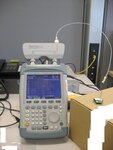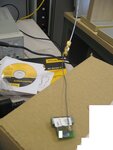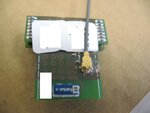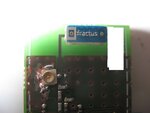Follow along with the video below to see how to install our site as a web app on your home screen.
Note: This feature may not be available in some browsers.




You should also detect continuity from the antenna jack to the via on top of the antenna.0 Ohm measured with Fluke voltimeter
You should also detect continuity from the antenna jack to the via on top of the antenna.
I didn't use 2.4 GHz chip antennas yet, my tests have been with Yageo 433 MHz. But even with unsuitable mounting position you would see a higher antenna radiation resistance. The about 10 ohm in the smith diagram looks like a tuned electrical small antenna without correct matching. It may be observed, if the chip antenna is actually broken. Don't know how.
I can be wrong but the ground area were connector is placed, it looks small. Looks as an isle not connected with other isles on PCB, cant see any vias, looks just as empty holes, is it a dual or single side PCB? In a case as this, I would never use a connector as it can cause so many hidden errors. It is better to sold coax-cable directly on PCB. As impedance is unexpected low in smith diagram, is it a unwanted parallel load somewhere.
Remove some extra trace backward against transmission chip, so it clearly is cut. Using ferrite beads around your cable is a good practice, always. See the PCB picture here.
I reviewed the information given in the thread and there are some unclear points in my opinion.
- You showed the calibration setup in post #1. I don't see a photo with the antenna reconnected after calibration (with a jumper wire or similar). Did you perform the antenna measurement on the same board after calibration?

- You reported Würth 7488910245 has shown a similar VSWR. In fact, it's intended for vertical mount position without an interconnecting small PCB trace. However, did it also show a similar Smith diagram? Did you test the Würth antenna in a vertical mount position?
- E Kafeman has asked, if the transmitter side has been realiably disconnected in the measurement. I presume it is, but the void can't be clearly seen in the photos.
- I think, the most important difference to the Fractus/TI reference design is the 1.1 mm reduced spacing between antenna and board, although I can't imagine yet an impact as observed in the measurement. Did you try to modify this feature, e.g. my milling or cutting 1 mm copper pour from top and bottom side or placing the antenna at a more distant position, connected by a wire?
That's clear so far. I wondered, how the antenna had been connected after calibration, and if it's been measured on the same board.Yes. The antenna is connected to feed point. Here the PCB i use
Yes, the difference is in a slightly higher capacitive load to the antenna connecting trace and the antenna itself. It can be expected to de-tune it somewhat, but not to change the impedance drastically. The interesting point is, that antenna seems to be still tuned, but strongly mismatched.The thickness in the current PCB is incorret so microstrip lumped elements and the final microstrip line are wrong matched. I mean, their Z0 are different from the original reference design. We have to correct it but actually it shouldn´t affect my measurements i think because i calibrate VNA after transmision line.